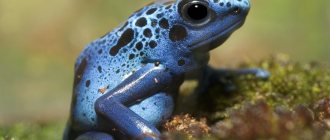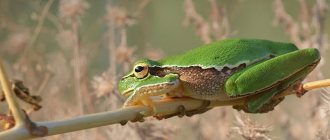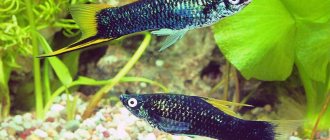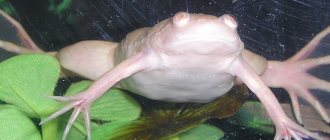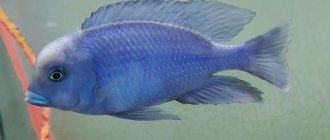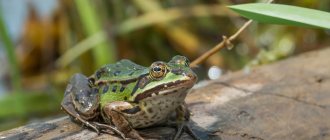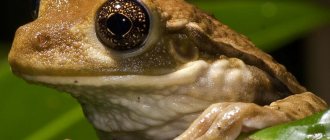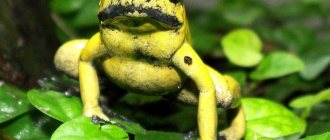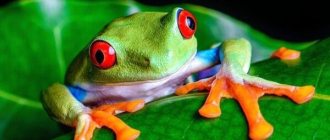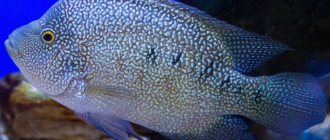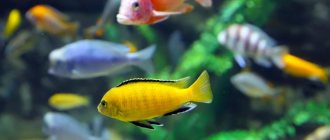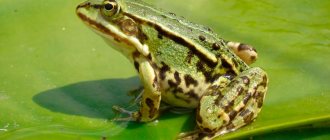Description
The blue dart frog is a tailless amphibian from the family Dart frog (Dendrobatidae). The subspecies are currently not studied.
The body length of the blue dart frog is 3.5-4.5 cm. Males are shorter than females by about 0.5 cm. Weight is 3-6 grams.
The size of frogs in natural conditions is 3.5-4.5 cm
Life expectancy in the wild is 7 years, in a terrarium – 10-12 years.
Terrarists often call them azureus, as well as azure poison dart frogs. The species is listed in the International Red Book.
Classification[ | ]
The taxonomy of tree frogs is still controversial. Depending on whether molecular biology or morphological comparative characteristics are emphasized, different taxonomies have been proposed by different authors. The most complete revision in recent years has led to a large number of regroupings and renamings[18]. The former subfamily Hemiphractinae has been completely ungrouped and is now considered a separate family, Hemiphractidae. New genera were created, and some species were transferred from one genera to another. In the genus Hyla
, which was once the most extensive and contained more than 300 species, only 16 species remain. As of October 2022, the family includes 7 subfamilies, 52 genera and 716 species[15], but this taxonomy is not final[1]:
Acridinae
Mivart, 1869
- Acris Duméril & Bibron, 1841 – Cricket tree frogs (3 species)
- Hyliola Mocquard, 1899 (4 species)
- Hyliola cadaverina (Cope, 1866) - California tree frog
- Hyliola hypochondriaca (Hallowell, 1854)
- Hyliola regilla (Baird & Girard, 1852) - King's tree frog
- Hyliola sierra (Jameson, Mackey, and Richmond, 1966)
- Pseudacris Fitzinger, 1843 - Marsh tree frogs (14 species)
Cophomantinae
Hoffman, 1878
- Aplastodiscus Lutz, 1950 - Thin-toed tree frogs (15 species)
- Boana Gray, 1825 (93 species)
- Bokermannohyla Faivovich et al., 2005 (32 species)
- Hyloscirtus Peters, 1882 (37 species)
- Hyloscirtus albopunctulatus (Boulenger, 1882) - Fringed-footed tree frog
- Hyloscirtus alytolylax (Duellman, 1972) - Long-voiced tree frog
- Hyloscirtus antioquia Rivera-Correa & Faivovich, 2013
- Hyloscirtus armatus (Boulenger, 1902)
- Hyloscirtus bogotensis (Peters, 1882) - Speckled tree frog
- Hyloscirtus callipeza (Duellman, 1989)
- Hyloscirtus caucanus (Ardila-Robayo at al., 1993)
- Hyloscirtus charazani (Vellard, 1970) - Bolivian tree frog
- Hyloscirtus chlorosteus (Reynolds & Foster, 1992)
- Hyloscirtus colymba (Dunn, 1931) - Short-striped tree frog
- Hyloscirtus condor Almendáriz at al., 2014
- Hyloscirtus criptico Coloma at al., 2012
- Hyloscirtus denticulentus (Duellman, 1972) - White-spotted tree frog
- Hyloscirtus diabolus Rivera-Correa, García-Burneo & Grant, 2016
- Hyloscirtus estevesi (Rivero, 1968)
- Hyloscirtus jahni (Rivero, 1961)
- Hyloscirtus japreria Rojas-Runjaic et al., 2018
- Hyloscirtus larinopygion (Duellman, 1973) - Blue-bellied tree frog
- Hyloscirtus lascinius (Rivero, 1970)
- Hyloscirtus lindae (Duellman & Altig, 1978) - Treefrog Trueb
- Hyloscirtus lynchi (Ruiz-Carranza & Ardila-Robayo, 1991)
- Hyloscirtus mashpi Guayasamin at al., 2015
- Hyloscirtus pacha (Duellman & Hillis, 1990)
- Hyloscirtus palmeri (Boulenger, 1908) - Brown-eyed tree frog
- Hyloscirtus pantostictus (Duellman & Berger, 1982) - Yellow-toed tree frog
- Hyloscirtus phyllognathus (Melin, 1941) - Olive tree frog
- Hyloscirtus piceigularis (Ruiz-Carranza & Lynch, 1982) - Transparent-bellied tree frog
- Hyloscirtus platydactylus (Boulenger, 1905) - Purple tree frog
- Hyloscirtus princecharlesi Coloma at al., 2012
- Hyloscirtus psarolaimus (Duellman & Hillis, 1990)
- Hyloscirtus ptychodactylus (Duellman & Hillis, 1990)
- Hyloscirtus sarampiona (Ruiz-Carranza & Lynch, 1982) - Orange-spotted tree frog
- Hyloscirtus simmonsi (Duellman, 1989)
- Hyloscirtus staufferorum (Duellman & Coloma, 1993)
- Hyloscirtus tapichalaca (Kizirian, Coloma & Paredes-Recalde, 2003)
- Hyloscirtus tigrinus Mueses-Cisneros & Anganoy-Criollo, 2008
- Hyloscirtus torrenticola (Duellman & Altig, 1978)
- Myersiohyla Faivovich et al., 2005 (6 species)
- Myersiohyla aromatica (Ayarzagüena & Señaris, 1994)
- Myersiohyla chamaeleo Faivovich, McDiarmid & Myers, 2013
- Myersiohyla inparquesi (Ayarzagüena & Señaris, 1994)
- Myersiohyla liliae (Kok, 2006)
- Myersiohyla loveridgei (Rivero, 1961) - Speckled tree frog
- Myersiohyla neblinaria Faivovich, McDiarmid & Myers, 2013
- Nesorohyla Faivovich et al., 2005 (1 species)
- Nesorohyla kanaima (Goin and Woodley, 1969)
Dendropsophinae
Fitzinger, 1843
- Dendropsophus Fitzinger, 1843 (105 species)
- Xenohyla Izecksohn, 1998 (2 species)
- Xenohyla eugenioi Caramaschi, 1998
- Xenohyla truncata (Izecksohn, 1959) - Diamond-eyed tree frog
Hylinae
Rafinesque, 1815
- Atlantihyla Faivovich et al., 2022 (2 species)
- Atlantihyla panchoi (Duellman and Campbell, 1982)
- Atlantihyla spinipollex (Schmidt, 1936)
- Bromeliohyla Faivovich et al., 2005 (3 species)
- Bromeliohyla bromeliacia (Schmidt, 1933) - Bromeliad tree frog
- Bromeliohyla dendroscarta (Taylor, 1940) - Banded tree frog
- Bromeliohyla melacaena (McCranie & Castañeda, 2006)
- Charadrahyla Faivovich et al., 2005 (9 species)
- Charadrahyla altipotens (Duellman, 1968) - Razor-faced tree frog
- Charadrahyla chaneque (Duellman, 1961)
- Charadrahyla esperancensis Canseco-Márquez, Ramírez-González, and González-Bernal, 2017
- Charadrahyla juanitae (Snyder, 1972)
- Charadrahyla nephila (Mendelson & Campbell, 1999)
- Charadrahyla pinorum (Taylor, 1937)
- Charadrahyla taeniopus (Günther, 1901) - Banded tree frog
- Charadrahyla tecuani Campbell, Blancas-Hernández & Smith, 2009
- Charadrahyla trux (Adler & Dennis, 1972) - Chocolate tree frog
- Dryophytes Fitzinger, 1843 (18 species)
- Dryophytes andersonii (Baird, 1854)
- Dryophytes arboricola (Taylor, 1941)
- Dryophytes arenicolor Cope, 1866
- Dryophytes avivoca (Viosca, 1928)
- Dryophytes bocourti (Mocquard, 1899)
- Dryophytes chrysoscelis (Cope, 1880)
- Dryophytes cinereus (Schneider, 1799)
- Dryophytes euphorbiaceus (Günther, 1858)
- Dryophytes eximius (Baird, 1854)
- Dryophytes femoralis (Daudin, 1800)
- Dryophytes gratiosus (LeConte, 1856)
- Dryophytes immaculatus (Boettger, 1888)
- Dryophytes japonicus (Günther, 1859)
- Dryophytes plicatus (Brocchi, 1877)
- Dryophytes squirellus (Daudin, 1800)
- Dryophytes versicolor (LeConte, 1825)
- Dryophytes walkeri (Stuart, 1954)
- Dryophytes wrightorum (Taylor, 1939)
- Duellmanohyla Campbell & Smith, 1992 (8 species)
- Ecnomiohyla Faivovich et al., 2005 (12 species)
- Ecnomiohyla bailarina Batista et al., 2014
- Ecnomiohyla echinata (Duellman, 1961) - Spine-toed tree frog
- Ecnomiohyla fimbrimembra (Taylor, 1948) - Fringed tree frog
- Ecnomiohyla miliaria (Cope, 1886) - Phantasmagoric tree frog
- Ecnomiohyla minera (Wilson, McCranie & Williams, 1985)
- Ecnomiohyla phantasmagoria (Dunn, 1943)
- Ecnomiohyla rabborum (Mendelson at al., 2008
- Ecnomiohyla salvaje (Wilson, McCranie & Williams, 1985)
- Ecnomiohyla sukia (Savage & Kubicki, 2010
- Ecnomiohyla thysanota (Duellman, 1966) - Panama tree frog
- Ecnomiohyla valancifer (Firschein & Smith, 1956)
- Ecnomiohyla veraguensis (Batista at al., 2014
- Exerodonta Brocchi, 1879 (9 species)
- Exerodonta abdivita (Campbell & Duellman, 2000)
- Exerodonta bivocata (Duellman & Hoyt, 1961)
- Exerodonta catracha (Porras & Wilson, 1987)
- Exerodonta chimalapa (Mendelson & Campbell, 1994)
- Exerodonta melanomma (Taylor, 1940) - Dark-spotted tree frog
- Exerodonta perkinsi (Campbell & Brodie, 1992)
- Exerodonta smaragdina (Taylor, 1940)
- Exerodonta sumichrasti Brocchi, 1879
- Exerodonta xera (Mendelson & Campbell, 1994)
- Hyla Laurenti, 1768 – Tree frogs (16 species)
- Isthmohyla Faivovich et al., 2005 (14 species)
- Isthmohyla angustilineata (Taylor, 1952) - Thin-striped tree frog
- Isthmohyla calypsa (Lips, 1996)
- Isthmohyla debilis (Taylor, 1952) - Bronze-eyed tree frog
- Isthmohyla graceae (Myers & Duellman, 1982) - Two-striped tree frog
- Isthmohyla infucata (Duellman, 1968)
- Isthmohyla insolita (McCranie, Wilson & Williams, 1993)
- Isthmohyla lancasteri (Barbour, 1928) - Tuberous tree frog
- Isthmohyla picadoi (Dunn, 1937) - Two-toothed tree frog
- Isthmohyla pictipes (Cope, 1875) - Yellow-legged tree frog
- Isthmohyla pseudopuma (Günther, 1901) - Still-water tree frog
- Isthmohyla rivularis (Taylor, 1952) - River tree frog
- Isthmohyla tica (Starrett, 1966) - Orange-legged tree frog
- Isthmohyla xanthosticta (Duellman, 1968) - Yellow-spotted tree frog
- Isthmohyla zeteki (Gaige, 1929) - Flat tree frog
- Megastomatohyla Faivovich et al., 2005 (4 species)
- Megastomatohyla mixe (Duellman, 1965)
- Megastomatohyla mixomaculata (Taylor, 1950) - Golden-eyed tree frog
- Megastomatohyla nubicola (Duellman, 1964) - Mist tree frog
- Megastomatohyla pellita (Duellman, 1968) - Hidden-eared tree frog
- Plectrohyla Brocchi, 1877 - Cascoheads (19 species)
- Ptychohyla Taylor, 1944 - Ferruginous tree frogs (8 species)
- Ptychohyla dendrophasma (Campbell, Smith & Acevedo, 2000)
- Ptychohyla euthysanota (Kellogg, 1928) - Rusty tree frog
- Ptychohyla hypomykter McCranie & Wilson, 1993
- Ptychohyla legleri (Taylor, 1958)
- Ptychohyla leonhardschultzei (Ahl, 1934) - Ferruginous tree frog
- Ptychohyla macrotympanum (Tanner, 1957)
- Ptychohyla salvadorensis (Mertens, 1952)
- Ptychohyla zophodes Campbell & Duellman, 2000
- Quilticohyla Faivovich et al., 2022 (4 species)
- Quilticohyla acrochorda (Campbell and Duellman, 2000)
- Quilticohyla erythromma (Taylor, 1937)
- Quilticohyla sanctaecrucis (Campbell and Smith, 1992)
- Quilticohyla zoque (Canseco-Márquez et al., 2017)
- Rheohyla Duellman, Marion, and Hedges, 2016 (1 species)
- Rheohyla miotympanum (Cope, 1863)
- Sarcohyla Duellman, Marion, and Hedges, 2016 (24 species)
- Sarcohyla ameibothalame (Canseco-Márquez et al., 2002)
- Sarcohyla arborescandens (Taylor, 1939)
- Sarcohyla bistincta (Cope, 1877)
- Sarcohyla calvicollina (Toal, 1994)
- Sarcohyla celata (Toal and Mendelson, 1995)
- Sarcohyla cembra (Caldwell, 1974)
- Sarcohyla charadricola (Duellman, 1964)
- Sarcohyla chryses (Adler, 1965)
- Sarcohyla crassa (Brocchi, 1877)
- Sarcohyla cyanomma (Caldwell, 1974)
- Sarcohyla cyclada (Campbell and Duellman, 2000)
- Sarcohyla hapsa Campbell et al., 2018
- Sarcohyla hazelae (Taylor, 1940)
- Sarcohyla labeculata (Shannon, 1951)
- Sarcohyla labedactyla (Mendelson and Toal, 1996)
- Sarcohyla miahuatlanensis (Meik et al., 2006)
- Sarcohyla mykter (Adler and Dennis, 1972)
- Sarcohyla pachyderma (Taylor, 1942)
- Sarcohyla pentheter (Adler, 1965)
- Sarcohyla psarosema (Campbell and Duellman, 2000)
- Sarcohyla robertsorum (Taylor, 1940)
- Sarcohyla sabrina (Caldwell, 1974)
- Sarcohyla siopela (Duellman, 1968)
- Sarcohyla thorectes (Adler, 1965)
- Smilisca Cope, 1865 - Smilisca (9 species)
- Tlalocohyla Faivovich et al., 2005 (4 species)
- Tlalocohyla godmani (Günther, 1901) - Veracruz tree frog
- Tlalocohyla loquax (Gaige & Stuart, 1934) - Red-legged tree frog
- Tlalocohyla picta (Günther, 1901)
- Tlalocohyla smithii (Boulenger, 1902)
- Triprion Cope, 1866 - Helmeted tree frogs (3 species)
- Triprion petasatus (Cope, 1865) - Helmeted tree frog
- Triprion spatulatus Günther, 1882
- Triprion spinosus (Steindachner, 1864)
Lophyohylinae
Miranda-Ribeiro, 1926
- Aparasphenodon Miranda-Ribeiro, 1920 – Combheads (5 species)
- Aparasphenodon arapapa Pimenta, Napoli & Haddad, 2009
- Aparasphenodon bokermanni Pombal, 1993
- Aparasphenodon brunoi Miranda Ribeiro, 1920 - Brazilian combhead
- Aparasphenodon pomba Lopes de Assis at al., 2013
- Aparasphenodon venezolanus (Mertens, 1950) - Venezuelan combhead
- Argenteohyla Trueb, 1970 – Cassette tree frogs (1 species)
- Corythomantis Boulenger, 1896 – Shield-headed tree frogs (2 species)
- Dryaderces Jungfer et al., 2013 (2 species)
- Dryaderces inframaculata (Boulenger, 1882) - Dark-sided tree frog
- Dryaderces pearsoni (Gaige, 1929)
- Itapotihyla Faivovich et al., 2005 (1 species)
- Itapotihyla langsdorffii (Duméril & Bibron, 1841) - Langsdorff's bonehead
- Nyctimantis Boulenger, 1882 – Hollow tree frogs (1 species)
- Nyctimantis rugiceps Boulenger, 1882 - Hollow tree frog
- Osteocephalus Steindachner, 1862 - Boneheads (24 species)
- Osteocephalus alboguttatus (Boulenger, 1882) - Speckled tree frog
- Osteocephalus buckleyi (Boulenger, 1882) - Bladder-sided boneheads
- Osteocephalus cabrerai (Cochran & Goin, 1970)
- Osteocephalus camufatus Jungfer at al., 2016
- Osteocephalus cannatellai Ron at al., 2012
- Osteocephalus carri (Cochran & Goin, 1970)
- Osteocephalus castaneicola Moravec at al., 2009
- Osteocephalus deridens Jungfer at al., 2000
- Osteocephalus duellmani Jungfer, 2011
- Osteocephalus festae (Peracca, 1904)
- Osteocephalus fuscifacies Jungfer at al., 2000
- Osteocephalus helenae (Ruthven, 1919) - Guyana tree frog
- Osteocephalus heyeri Lynch, 2002
- Osteocephalus leoniae Jungfer & Lehr, 2001
- Osteocephalus leprieurii (Duméril & Bibron, 1841) - Cross-striped bonehead
- Osteocephalus mimeticus (Melin, 1941)
- Osteocephalus mutabor Jungfer & Hodl, 2002
- Osteocephalus oophagus Jungfer & Schiesari, 1995
- Osteocephalus planiceps Cope, 1874
- Osteocephalus subtilis Martins & Cardoso, 1987
- Osteocephalus taurinus Steindachner, 1862 - Amazonian bonehead
- Osteocephalus verruciger (Werner, 1901) - Warty bonehead
- Osteocephalus vilarsi (Melin, 1941)
- Osteocephalus yasuni Ron & Pramuk, 1999
- Osteopilus Fitzinger, 1843 - West Indian tree frogs (8 species)
- Phyllodytes Wagler, 1830 - Phyllodytes (species)
- Phytotriades Jowers, Downieb, and Cohen, 2009 (1 species)
- Phytotriades auratus (Boulenger, 1917)
- Tepuihyla Ayarzagüena, Señaris & Gorzula, 1993 (9 species)
- Tepuihyla aecii Ayarzagüena, Señaris & Gorzula, 1993
- Tepuihyla edelcae (Ayarzagüena, Señaris & Gorzula, 1993)
- Tepuihyla exophthalma (Smith & Noonan, 2001)
- Tepuihyla luteolabris Ayarzagüena, Señaris & Gorzula, 1993
- Tepuihyla obscura Kok at al., 2015
- Tepuihyla rodriguezi (Rivero, 1968)
- Tepuihyla shushupe Ron at al., 2016
- Tepuihyla tuberculosa (Boulenger, 1882) - Warty tree frog
- Tepuihyla warreni (Duellman & Hoogmoed, 1992)
- Trachycephalus Tschudi, 1838 - Shellheads (17 species)
Pseudinae
Fitzinger, 1843
- Lysapsus Cope, 1862 - Blunt-snouted pseudos (4 species)
- Lysapsus bolivianus (Gallardo, 1961)
- Lysapsus caraya Gallardo, 1964
- Lysapsus laevis (Parker, 1935)
- Lysapsus limellum Cope, 1862
- Pseudis Wagler, 1830 - Pseudis (7 species)
- Scarthyla Duellman & de Sá, 1988 (2 species)
- Scarthyla goinorum (Bokermann, 1962)
- Scarthyla vigilans (Solano, 1971) - Venezuelan tree frog
Scinaxinae
Duellman, Marion, and Hedges, 2016
- Julianus Duellman, Marion, and Hedges, 2016 (2 species)
- Julianus pinimus (Bokermann and Sazima, 1973)
- Julianus uruguayus (Schmidt, 1944)
- Ololygon Fitzinger, 1843 (48 species)
- Ololygon agilis (Cruz and Peixoto, 1983)
- Ololygon albicans (Bokermann, 1967)
- Ololygon alcatraz (Lutz, 1973)
- Ololygon angrensis (Lutz, 1973)
- Ololygon arduous (Peixoto, 2002)
- Ololygon argyreornata (Miranda-Ribeiro, 1926)
- Ololygon ariadne (Bokermann, 1967)
- Ololygon aromothyella (Faivovich, 2005)
- Ololygon atrata (Peixoto, 1989)
- Ololygon belloni (Faivovich, Gasparini, and Haddad, 2010)
- Ololygon berthae (Barrio, 1962)
- Ololygon brieni (De Witte, 1930)
- Ololygon caissara (Lourenço, Zina, Catroli, Kasahara, Faivovich, and Haddad, 2016)
- Ololygon canastrensis (Cardoso and Haddad, 1982)
- Ololygon carnevallii Caramaschi and Kisteumacher, 1989
- Ololygon catharinae (Boulenger, 1888)
- Ololygon centralis (Pombal and Bastos, 1996)
- Ololygon cosenzai (Lacerda, Peixoto, and Feio, 2012)
- Ololygon faivovichi (Brasileiro, Oyamaguchi, and Haddad, 2007)
- Ololygon flavoguttata (Lutz and Lutz, 1939)
- Ololygon goya Andrade, Santos, Rocha, Pombal, and Vaz-Silva, 2018
- Ololygon heyeri Peixoto and Weygoldt, 1986
- Ololygon hiemalis (Haddad and Pombal, 1987)
- Ololygon humilis (A. Lutz and B. Lutz, 1954)
- Ololygon insperata (Silva and Alves-Silva, 2011)
- Ololygon jureia (Pombal and Gordo, 1991)
- Ololygon kautskyi Carvalho-e-Silva and Peixoto, 1991
- Ololygon littoralis (Pombal and Gordo, 1991)
- Ololygon littoreus Peixoto, 1988
- Ololygon longilinea (Lutz, 1968)
- Ololygon luizotavioi Caramaschi and Kisteumacher, 1989
- Ololygon machadoi (Bokermann and Sazima, 1973)
- Ololygon melanodactyla (Lourenço, Luna, and Pombal, 2014)
- Ololygon melloi Peixoto, 1989
- Ololygon muriciensis (Cruz, Nunes, and Lima, 2011)
- Ololygon obtriangulata (Lutz, 1973)
- Ololygon peixotoi (Brasileiro, Haddad, Sawaya, and Martins, 2007)
- Ololygon perpusilla (Lutz and Lutz, 1939)
- Ololygon pombali (Lourenço, Carvalho, Baêta, Pezzuti, and Leite, 2013)
- Ololygon ranki (Andrade and Cardoso, 1987)
- Ololygon rizibilis (Bokermann, 1964)
- Ololygon skaios (Pombal, Carvalho, Canelas, and Bastos, 2010)
- Ololygon skuki (Lima, Cruz, and Azevedo, 2011)
- Ololygon strigilata (Spix, 1824)
- Ololygon trapicheiroi (A. Lutz and B. Lutz, 1954)
- Ololygon tripui (Lourenço, Nascimento, and Pires, 2010)
- Ololygon tupinamba (Silva and Alves-Silva, 2008)
- Ololygon v-signata (Lutz, 1968)
- Scinax Wagler, 1830 (72 species)
- Sphaenorhynchus Tschudi, 1838 - Wedgeheads (15 species)
- Sphaenorhynchus botocudo Caramaschi, Almeida & Gasparini, 2009
- Sphaenorhynchus bromelicola Bokermann, 1966 - Bromeliad wedgehead
- Sphaenorhynchus cammaeus Roberto at al., 2017
- Sphaenorhynchus canga Araujo-Vieira at al., 2015
- Sphaenorhynchus caramaschii Toledo at al., 2007
- Sphaenorhynchus carneus (Cope, 1868) - Red-green wedgehead
- Sphaenorhynchus dorisae (Goin, 1957) - Wedgehead Cochran
- Sphaenorhynchus lacteus (Daudin, 1800) - Golden wedgehead
- Sphaenorhynchus mirim Caramaschi, Almeida & Gasparini, 2009
- Sphaenorhynchus palustris Bokermann, 1966 - Swamp wedgehead
- Sphaenorhynchus pauloalvini Bokermann, 1973 - Brazilian wedgehead
- Sphaenorhynchus planicola (Lutz & Lutz, 1938) - Plains wedgehead
- Sphaenorhynchus platycephalus (Werner, 1894)
- Sphaenorhynchus prasinus Bokermann, 1973 – Green wedgehead
- Sphaenorhynchus surdus (Cochran, 1953) - Paranaian wedgehead
Species incertae sedis
- Hyla imitator (Barbour and Dunn, 1921)
- Hyla nicefori (Cochran and Goin, 1970)
History of the breed
In the late 60s, researchers discovered a blue frog in tropical rainforests. The bright shade stood out against the general background. Because of its poisonous properties, the natives named the frog okopipi - “poison arrow frog”.
Scientists suggest that the Azureus survived the Ice Age only thanks to cryosleep. Maybe for this reason they have an “icy” color.
The species was first described in 1797 by French zoologist Frederic Cuvier.
Varieties
There are at least 175 varieties of brightly colored tree frogs. However, only 3 of them pose a mortal danger to humans. Other amphibians are not poisonous; with the help of their distinctive color they protect themselves from predators. Those tree nymphs that can actually cause death prefer solitude; they gather in groups only during the mating season, when they reach the age of 2 years. They attack large animals only if they sense danger. They strive to protect their home.
Habitat
The habitat of the blue dart frog is a small area of the Sipaliwini River in South America. This site is located in the south of Suriname and borders Brazil and French Guiana.
Frogs live in the rainforests of South and Central America
Azureus prefer tropical rain forests with rocky soil at altitudes up to 400 m above sea level. They live in dense thickets or under piles of fallen leaves near lakes or puddles. The temperature there during the day ranges from 22° to 27°C, and at night - 20°C.
Due to its very small range, Dendrobates azureus is on the verge of extinction. The main reason is deforestation by surrounding residents.
Behavior
Blue dart frogs in the wild coexist on land in mixed groups of up to 60 individuals. They lead a daily lifestyle. They walk almost all day, alternately moving their paws, and less often jump on the forest floor in search of food.
Dart frogs lead an active daily lifestyle
Males protect the areas occupied by their “harem”. They use sounds to inform opponents about this. And if their territory is encroached upon, they furiously try to push the invader out of it.
Their fights are similar to freestyle wrestling. The male, who is defeated, bows his head to the ground. It happens that fights end in the death of an opponent due to broken limbs.
Poisonous or not
The venom of the blue dart frog in nature is not as strong as that of the terrible leaf climber, one of the representatives of the Dendrobatidae family.
The Tiriyo Indian tribes from the tropical forests of the Sipaliwini savannah smear arrows with the poisonous secretion of Azureus when they hunt small animals.
Under natural conditions, frogs accumulate poison by eating poisonous ants. It is released from a huge number of glands when the skin of an amphibian is touched. The poisonous secretion protects it from fungi and bacteria, as well as from enemies in natural conditions.
Frog caviar oil: medicinal uses
Doctors have also found benefits in tree frog caviar, extracting from it what appears to be a medically useful oil.
So, oil from tree frog caviar, or rather, the drug that is produced on its basis, helps cleanse the blood and blood vessels, effectively treat hypertension, diabetes, and stroke. It is also recommended for high cholesterol levels, low immunity and weakened sexual functions. In any case, prior consultation with a doctor before using such drugs is required.
Diseases
Dart frogs are rather gentle creatures, and therefore, when kept in terrariums, they are often susceptible to diseases such as:
- dropsy,
- intestinal obstruction,
- pneumonia;
- blood poisoning;
- infectious pathologies;
- mycosis;
- rotting of bone and cartilage tissue;
- salmonellosis.
Many of these diseases are difficult to treat and therefore deadly. Experts and veterinarians recommend strictly following the regimen and diet of azure dart frogs, as well as the basic conditions for keeping pets, non-compliance with which often causes diseases.
Be sure to contact your veterinarian if you notice any symptoms of the disease.
If alarming symptoms are detected in an amphibian, you should immediately contact a veterinarian
Price and where to buy
Due to the small population, it is not very easy to acquire poison dart frog. You are unlikely to find it in a regular pet store. But it is possible to order on a specialized website. It is important to contact a trusted seller.
The price will depend on the age of the dart frog and the regional location of the buyer. You can buy a baby blue dart frog for about 2000-2500 rubles. A female up to 1 year old can be bought for 5,000 rubles.
Blue dart frogs are spectacular, bright, unusual frogs that will decorate any terrarium.
Dart frogs are beautiful and unusual frogs that will become a worthy decoration for any terrarium.
Such beauties can be given names, because it is easy to distinguish them thanks to the individuality of color. Given the right conditions, these amazing amphibians will delight and amuse the owner for many years.
Are you interested in the blue dart frog? Or maybe you kept such a pet in an aquarium? Share your opinion and experience in the comments.
Appearance of a tree frog
Tree frogs belong to the family of tailless amphibians, and include more than 800 species of tree frogs. The main difference between these frogs and others is the presence of special suction cups on their feet, thanks to which they are able to move vertically.
Such suction cups on the fingers are equipped with additional muscles that relax them and allow them to press more tightly to the substrate. In addition to such Velcro, there are also sticky areas on the skin of the abdomen and throat.
The second difference between tree frogs is that many species are brightly colored, as can be seen in the photo. Shocking neon green, bright yellow, green-orange, and red colors highlight this amphibian, warning those who want to dine on it that this lunch will not only be the last in the life of the frog, because they are usually very poisonous.
Tree frogs are most often brightly colored
But there are also less noticeable species - gray or brown, for example, American tree frog . And the squirrel tree frog can even change color, adapting to the world around it.
The size of these amphibians depends on the species, and the largest of them are only up to 14 cm in length. On average, their size is only 2-4 cm, and dwarf tree frogs are generally a little more than a centimeter.
This is not surprising, because the heavy weight of the steeple frog cannot be supported by thin branches and leaves of trees. Males are smaller than females, but they have a leather pouch under their throats, which they can beautifully inflate and make sounds to them.
Tree frogs' eyes typically protrude from their heads, providing binocular vision. The pupils are most often located vertically. The tongue is long and sticky, very useful for hunting insects.
Separately, it is worth mentioning the toxicity of the tree frog - not everything is so scary for humans. Some generally only disguise themselves as dangerous. To be poisoned, you must allow the poison to enter the body.
Touching with hands can be unpleasant and painful, but not fatal. It is believed that poisonousness is not an innate quality of the frog. Studies have shown that the poison is adsorbed from insects, which contain them in minimal doses.
